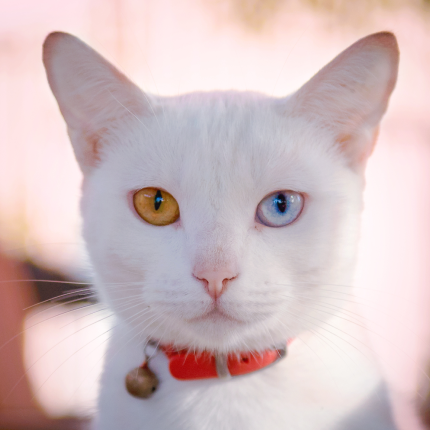The 5 (or 6) Main Cat Senses

Our cats’ whiskers work as antennae, their ears serve as satellite dishes, and their dual scent mechanism outperforms even the most sensitive dogs with their noses. Cats have a fascinating sensory world that is, in many ways, unique. Discover some fascinating facts about cats and how their senses work to bring the world into sharp focus.
advertisement
Sight
A cat’s eyesight might not be ideal for painting works of art, but it is perfect for hunting in the middle of the night. They are proficient hunters because of their wide field of vision and ability to detect movement. One study found that cats’ ability to see in the dark is mainly due to their ability to see ultraviolet light that humans cannot detect. As a result, they hunt primarily during twilight, and their daylight vision is less heightened in the evening, which explains why your cat is crepuscular.
Scurrying mice might still go unnoticed despite their intelligent eyes. Under their chins, cats have a blind spot. You now know why your kitten can’t see things right under their noses!

Smell
The cat’s sense of smell is a wonderfully intricate mechanism that some researchers even rank above that of our trusted dogs, with almost 40 times more odor-sensitive cells than ours. Moreover, cats rely more on their noses than their eyes to figure out their environment. So whether a cat is bonding with its mother, hunting, mating, or exploring its surroundings, its sense of smell will provide the most reliable information.
Cats have a dual scent mechanism, a cool superpower that is quite rare in the animal kingdom. Similarly to other animals, cats have olfactory (scent) receptors that detect aromas in the air. In addition, cats have a second nose, located on the roof of their mouth, called the vomeronasal organ, which detects pheromone signatures that regular scent receptors cannot. It is essential for social, mating, and territorial communication.

Hearing
Humans might not notice a slight rustle in the leaves on the ground, but your kitten will quickly perk up its ears and investigate further. This is because cats can hear a wide range of frequencies thanks to their cone-shaped ears. Consequently, they can listen to more frequencies than most mammals, including humans.
The shape of a cat’s outer ear serves two purposes: it amplifies sound as it travels to the middle and inner ear and detects where the noise comes from. No wonder this cat sense has evolved into a unique detection mechanism when hunting or avoiding predators.

Taste
Cats’ senses are very sensitive, but their taste is strange. Only a few hundred taste buds are present in them, compared to over 9000 in humans! So cats, for example, cannot taste anything sweet, making them the only mammal who can’t. Many believe their heightened sense of smell compensates for their poor taste.
Lemons and coffee, however, should be kept away from your cat. Cats are not fans of bitter flavors, as bitter signals are interpreted as harmful or poisonous. However, bitter liquids and sprays sometimes prevent cats from biting and chewing furniture or wounds.

Touch
The cat’s sophisticated sense of touch supports and enhances its vision. Cats use their whiskers as radars and touch receptors to measure distances accurately. Whiskers are doing all the work if you see the cat navigating impossibly narrow spaces or gracefully leaping on thin ledges.
Their noses and paws also have touch receptors. So a cat’s fur always picks up sensory information, which contributes to a heightened sense of touch. It’s why your cat purrs whenever you stroke or pet him.
Your cat’s whiskers probably look like facial features to you. However, it turns out that the cat’s front legs also have whiskers. Since cats used to chase and hunt a lot, the front leg whiskers were crucial to detecting the position of the prey they were about to catch. For more information about leg whiskers, check out this post!
advertisement

Sixth sense?
Cats are mysterious creatures, and most owners wonder what they see when they stare intently at the couch or what they’re catching with their paws up in the air (could it be greebles?). Despite our best efforts, we can’t fully explain kitten behavior, which is why many owners believe cats have a sixth sense that can explain everything. Despite some cat lovers claiming they witnessed their cats detecting danger or communicating with unseen people, there is no solid evidence that cats can see things beyond the five senses.
However, It has been found that pairing a kitten with an autistic child or a dementia patient can be highly beneficial. Even if cats lack a sixth sense, their connection with patients can transform lives.
So there you have it: the extraordinary sensory abilities of cats. Next time you’re amazed by the extraordinary hunting ability you witness in your cat or wonder why your cat doesn’t want to share your ice cream, just remember what you’ve learned about how your cat experiences the world a little differently.

Featured Articles

Greebles and Cats: The Origin and the Meaning
You may have seen an internet sensation concerning cats labeled “greebles.” Feel out of the loop? We’re here to help you. In 2019, Reddit user /user/literallyatree commented on a Reddit post about a cat that looks like it’s trying to slap a ghost. This user commented: “My family calls things…

Why Do Cats Roll Over Into Their Backs But Not Let You Touch Their Bellies?
It’s common knowledge dogs love to have their tummies rubbed when they freely lay down before you and roll onto their backs. But, if you’re also familiar with cats, you know that when they roll onto their backs with their bellies exposed, rubbing the belly will most likely result in…

Polydactyl Cats: Just More Beans to Love
Polydactyl cats have become extremely popular in recent times. As a result, more and more people are interested in learning more about this six-toed cat and want to get one of their own. If you are a cat lover intrigued by polydactyl cats, you have come to the right place….

